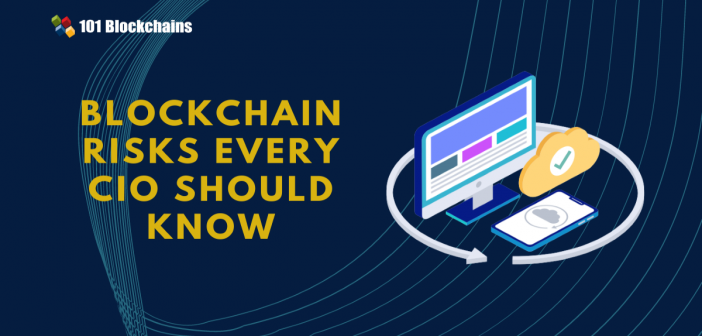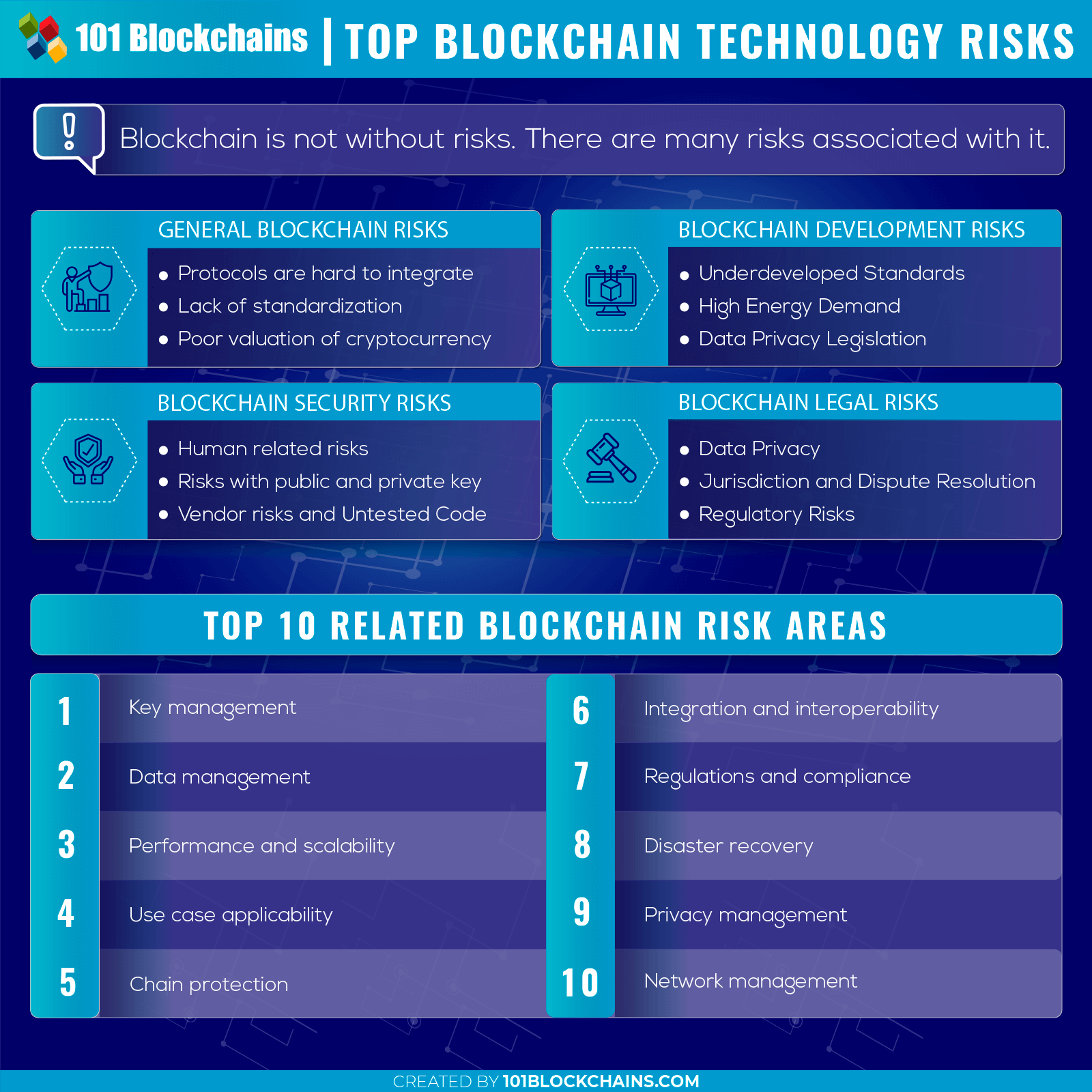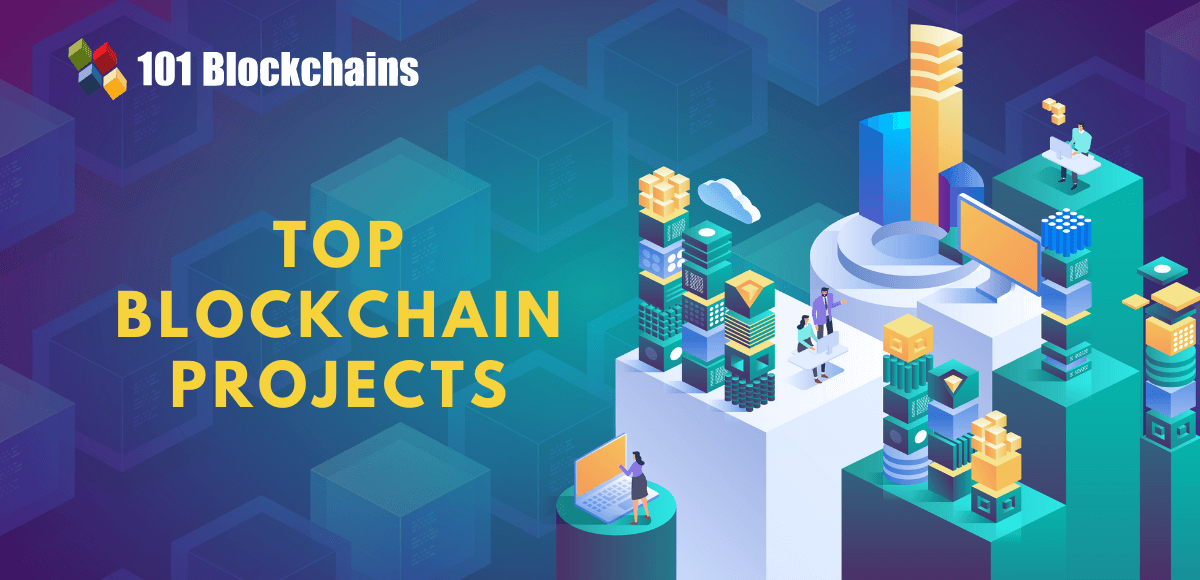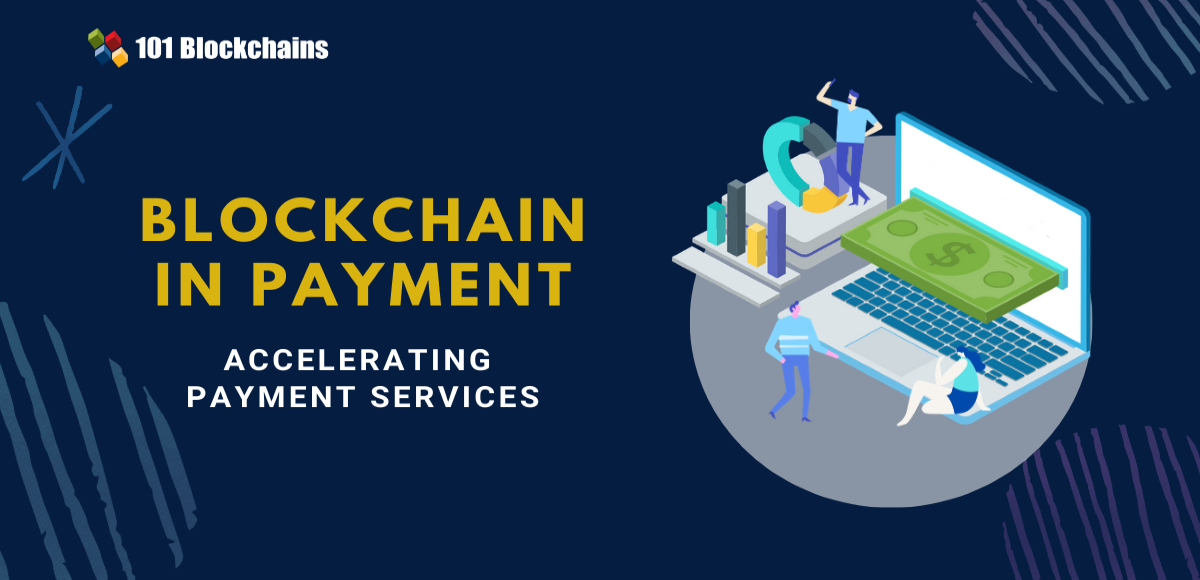In this article, we will go through the blockchain risks and try to understand blockchain from different perspectives, namely — general, development, legal, and security. Also, you’ll get a checklist to ensure if your organization is at risk!
Blockchain is a revolutionary idea. It has directly impacted different industries out there. However, blockchain is not free from risks. The risks can be related to technology, implementation, investment, legal, operational, security, finance, and other aspects directly or indirectly related to blockchain.
If you want advanced knowledge on enterprise blockchain, you must enroll in our Certified Enterprise Blockchain Professional (CEBP) course.
Types of Blockchain Risks
When we speak about blockchain, we specifically talk about the technology aspect of it. It is not the cryptocurrencies that utilize the blockchain technology.
But, when it comes to institutions such as banks, they do find cryptocurrency risky. One such tool created by Elliptic enables the bank to monitor bitcoin risks. It monitors the biggest entities that deal with bitcoin.
Apart from the viewpoint of banks, there are other risks associated with blockchain.
So, what are the blockchain risks?
Please include attribution to 101blockchains.com with this graphic. <a href='https://101blockchains.com/blockchain-infographics/'> <img src='https://101blockchains.com/wp-content/uploads/2019/07/Blockchain_Risks.png' alt='Blockchain Risks='0' /> </a>
General Blockchain Risks
The general blockchain risks that can impact any blockchain project include the following.
Blockchain Protocols Are Hard to Integrate
Blockchain is a new technology. This means that it becomes hard to include blockchain protocols into a project. According to Deloitte, it is hard to implement different blockchain projects. For example, if they want to share information from Hyperledger Fabric Protocol to Ethereum Protocol, they would need an integration layer that manages these two different enterprise systems
Want to know more about Hyperledger Fabric? Enroll Now: Getting Started with Hyperledger Fabric
Lack of Standardization
The wide variety of frameworks means that there is a lack of standardization. This is potentially one of the biggest risks that the current blockchain projects suffer from. These standards apply across the complete blockchain ecosystem including Initial Coin Offerings (ICO), cryptocurrencies, frameworks, and so on.
ICOs are suffering the most from the lack of standardization. The investors have no proper protection against the investment, which makes ICOs a big gamble. This article talks about how to launch ICO successfully.
Read Trade Finance Blockchain to get an idea of how standardization is hard.
Poor Valuation of Cryptocurrencies
Cryptocurrency prices are also one of the biggest concerns as they utilize blockchain. A reasonable cryptocurrency price also changes the market sentiment towards blockchain.
Bitcoin, which utilizes blockchain technology, can see high jumps that are beyond any investors guess. This also means that the prices can drop sharply, leaving a lot of investors empty-handed.
Clearly, the prices are not stable, and that’s one risks associated with the traders who bank on a project or a cryptocurrency that it is utilizing blockchain project.
Check out enterprise blockchain to learn about enterprise system
Blockchain Development Risks
Now, that we have gotten a glimpse of blockchain risks, let’s dive deep into the development aspect.
Right now, blockchain is being implemented in almost every sector. Be it the health sector or supply chain or even government. Everyone wants to make the most out of the groundbreaking technology.
Blockchain’s idea is now developed into Distributed Ledger Technology (DLT). There are many ways, the problem is trying to be solved, based on the concept of decentralization. For example, we can see the emergence of a Directed Acyclic Graph (DAG). It is been used in IOTA. Another DAG based DLT include Hyperledger. All of these evolved from blockchain and hence carried the same risks associated with blockchain.
The risks that are associated with blockchain development risks include the following:
Underdeveloped Standards
Every technology has a necessary standardization behind it. This means that it becomes easy for companies across the world to adopt the technology and enable worldwide usage. Right now, blockchain doesn’t have proper standards due to its rapid growth. With different organizations working on their “own” blockchain or DLT version, it is hard to standardize them. Blockchain and distributed ledger are two different concepts — learn more here, blockchain vs distributed ledger technology.
Also, the competition is exceptionally fierce, which makes it even harder for these organizations to work together towards the primary goal.
In the end, this leads to risks related to security, privacy, and interoperability.
High Energy Demand
Right now, there are many consensus methods. Considering all of them, it is easy to say that Proof-of-Work (PoW) is the most popular. Both Ethereum and Bitcoin utilize them. Ethereum being more popular when it comes to blockchain implementation.
Each of the consensus methods has its own advantages and disadvantages. PoW is an effective way to reach consensus as it rewards the miners for the work they are doing. However, the downside is the high energy cost. In PoW, each node has to compete with each other by solving a highly complex mathematical problem. To solve the problem, the miners have to invest in high-performance machines that require a lot of electricity to run.
With time, the blockchain developers understand its impact, and slowly, they are transforming to a more energy-friendly consensus method such as Proof-of-Stake (PoS).
Confused about Proof-of-Work (PoW) and Proof-of-Stake (PoS)? Check out this article on PoW Vs. PoS!
Data Privacy Legislation
Data Privacy is one of the most significant issues with blockchain or distributed ledger technology. Clearly, DLTs are designed, and that can play an impactful role in the current societal infrastructure. With different countries and regions implementing data privacy regulations such as the European Union General Data Protection Regulation, it is essential to do the same for blockchain.
The approach is not to declare your identity to the network, but that’s not always the case due to the Know Your Customers (KYC) and Anti-Money Laundering (AML) activities.
Trusting Blockchain Managers and Developers
Blockchain is an excellent concept that is trustless. However, it is a new technology, and many players are coming in, which makes the blockchain ecosystem more complex. It also means that as a consumer or an end user may find it hard to trust these new platforms.
The implementation is what matters, and the developers and managers will be responsible for these projects. This also means that they will be able to take significant decisions, including the type of cryptography algorithm to do, ability to a soft or hard fork, and so on. These decisions can be biased and would pose a risk to the core idea of blockchain itself.
The Users’ Role
The user is the core of the decentralized network. As there is no centralized authority, the user has to take all the responsibility when it comes to handling their accounts. This means that they have to take proper care of the private key — which is used to access the wallet or the information stored on the blockchain. If it is lost, the user will also lose access to his/her data. Also, there is no restore or retrieval option when it comes to blockchain. This brings a lot of user-oriented risks to blockchain technology.
Transaction Speed
One of the touted features of the blockchain networks is the time they take to settle down transactions. However, that might not be the case every time transactions take place. If we take the example of Bitcoin, it can take anywhere between ten minutes to a few hours for a transaction to get completed.
Scalability is also a big issue, and whenever there is congestion, the transaction rate can go down even more. So, how come this be a risk? For a user using a blockchain solution, he might not know the status of the network. If the transaction is urgent, he might feel stuck and may get adversely affected with it. The solution to this is a private network, but they also do come with their own disadvantages.
Malicious Users
Malicious users are part of any system or solution. Blockchain is no different. They can impact the blockchain network by controlling a particular aspect of it. The risks are real, and it is up to the developers to ensure that malicious actors in no condition can take control of the network resources or the consensus method.
Legal Related Blockchain Risks
There are also some legal risks associated with blockchain. Blockchain technology legal issues are more severe. To protect the users and also ensure that the blockchain technology is implemented correctly, the laws are enforced. Governments are also keen to govern new technology as they are centralized in nature and autocratic nature. However, most of the time, these rules are put forward to protect the interests of the user, the service provider, and the government as well.
If you are developing blockchain-related products or aim to indulge in a blockchain product, you should also know about blockchain legal risks. They are as below.
Data Privacy
Data privacy is the biggest concern when it comes to distributed ledger technology. We all know that it is decentralized and distributed. This means that all the information that is stored in a blockchain stays in blockchain, even if it is personal information. When we say it is distributed, we comply that the data has to be stored across different geographic locations. It also means that it can easily fall under a massive multitude of jurisdictions — making data privacy a very complex subject.
For starters, which data privacy law should the data follow? We can take the EU-US Privacy Shield, but that would only work for transactions that are done from the EU to the US or vice-versa. Even if it works for those regions, it doesn’t cover the other areas across the world.
The GDPR regulation is aimed explicitly towards EU citizens. All-in-All, the idea of data privacy is far-fetched when it comes to blockchain. One more thing that makes data privacy complex is the fact that the data is immutable on the blockchain. No user, in any case, can remove the information once stored from the blockchain database.
Jurisdiction and Dispute Resolution
The jurisdiction and dispute resolution are big concerns. A distributed ledger is all about a decentralized network, which makes applying jurisdiction an inevitable problem.
Modern blockchain cryptocurrencies such as Ethereum or others can help in this regard with the use of smart contracts. They can be coded to include a particular jurisdiction. However, the challenge is to enforce the use of the jurisdiction.
Also, questions like who will resolve a dispute if needed. The process of dispute resolution is also a big challenge that needs to be solved. Lastly, giving rewards to the one that solves is also needed to be decided. Overall, it is tough to resolve the issues considering the nature of the DLT.
Regulatory Risks
The last blockchain legal risk is a regulatory risk. Governments have to pass regulations to the DLT. In some cases, states are also empowered to make their own regulations, which can make things more complicated.
With the rise of digital currencies, it is common to have federal regulations so that it can protect the interest of the users, and keep the economy in balance.
Security Related Blockchain Risks
There are also security risks associated with blockchain. With more and more companies trying to jump into the blockchain technology, the security risks can be understood.
But, how does blockchain even suffer security risks? DLT’s are known for their excellent security. However, that doesn’t mean that they are entirely secure. They can still be attacked, and data or information can be stolen.
As a company, you need to understand that blockchain is also not completely secure and take precautionary steps to make it safe. To get an idea, below are the blockchain security risks.
Want to know more about blockchain security? Enroll Now: Certified Blockchain Security Expert (CBSE)
Human-Related Risks
Even though blockchain is completely decentralized, it still has to interact with humans to work correctly. In that case, new blockchain security risks come in. For example, any business who wants to interact with the blockchain system needs to do it either through a computer or automated systems. When a user interacts through a computer, at that point, there is a chance of credentials to access the systems can be stolen or compromised. It only happens at endpoints, which makes blockchain vulnerable. In fact, this is more of a user-based risk, but as blockchain has to interact with the user, it has to be defined under blockchain security risks.
Risks with Private and Public Key
The whole idea of blockchain or distributed ledger technology relies heavily on the public and private keys. These keys are a series of characters that offers unique security properties. One security property is that it is tough to guess.
Blockchain work with these keys. If you do not have the right combination of the public or private key, you simply cannot access the digital content stored within the blockchain. Hackers know that, and they also know that it is a waste of time in guessing those keys. That’s why they try to get the keys by attacking the weakest point, i.e., the system that is used by the user. It can be a mobile device or a personal computer.
In any of the case, the hacker can take advantage of the vulnerabilities shown by these devices. If you are using Android, they will simply try to install malware to get access to the information that you share through your device. If you input your private key, they can make a copy of it, and send it to their own computers. With the private key in hand, they can then access the information stored. Most of the time, it’s the user’s fault for not securing their systems.
Hardware-level vulnerabilities can also be exploited by hackers to gain access to a computer or a system.
As a user, your job is to make your system as secure as possible.
To ensure that you protect your device, you can do the following things.
- Update your device regularly.
- Use good antivirus and firewall
- Never store your keys in Word document, a text file or other type of file which the hacker can easily access it.
- Do not send or store your keys in email.
Vendor Risks
Many ad-hoc platforms and services work with DLTs to improve its functionality. With DLTs growth, it is evident that we will also see growth in 3rd party development. These include solutions such as wallets, payment processors, smart contracts, blockchain payment platforms, and so on.
These vendors also pose a risk to users. If the platform or service you are using has any form of vulnerability, then you can expect to have issues when accessing it. The security risks can come due to bad code, weak security, and wrong handling by the persons. Also, as most of these vendors use smart contracts, they have to ensure that their smart contracts are free from all kinds of flaws or security loopholes. If there is one, then it can easily lead to a system-wide effect.
Untested Code
The quality of the code remains a big concern to most of the blockchain solutions. Decentralized organizations need to take extra care when they deploy their solutions. One such example is the Decentralized Autonomous Organization (DAO) — what is DAO. It is an autonomous system that automates a certain or the whole organization.
DAO hack is one of the most popular hacks in the history of blockchain. It was created in 2016 and known as “The DAO.” It got hacked, which resulted in the loss of a huge amount of revenue. The split function was executed by the hacker as he attempted to transfer funds from the main account. He stole $55 million of Ether.
Not Tested at Full Scale
DLTs are mostly run on a small scale before going live. To test the DLT, the developers need to use testnet which simulates the network. They can do a wide range of tests. However, it doesn’t cover the issues that can come at full scale.
Is Your Organization Prepared?
There are 10 related blockchain risk factors. They are as below.
- Key management
- Data management
- Performance and scalability
- Use case applicability
- Chain protection
- Integration and interoperability
- Regulations and compliance
- Disaster recovery
- Privacy and chain management
- Network and consensus management.
These specific areas need to be taken care of while developing blockchain-related applications or distributed ledger solutions.
Enroll Now: Enterprise Blockchains Fundamentals Course
Final Thoughts
As an organization, you need to understand that blockchain is not the solution to every problem out there. It may improve specific processes, but it does cost a lot during the initial stage. Also, some risks need to be taken care of. In this article, we discussed a wide variety of risks, including security, legal, and development. So, what do you think about the blockchain risks and potential blockchain risk management? Comment below and let us know.
If you are curious about the blockchain risks and basic fundamentals, make sure to check our free blockchain fundamentals course.





